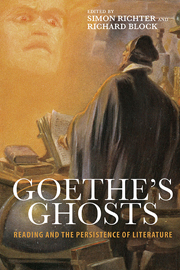Book contents
- Frontmatter
- Contents
- Introduction—Ghosts and the Machine: Reading with Jane Brown
- Part I The Ghosts of Goethe's Past
- 1 Egologies: Goethe, Entoptics, and the Instruments of Writing Life
- 2 Goethe's Haunted Architectural Idea
- 3 “Über allen Gipfeln”: The Poem as Hieroglyph
- 4 Goethe's Hauskapelle and Sacred Choral Music
- 5 From Haunting Visions to Revealing (Self-)Reflections: The Goethean Hero between Subject and Object
- Part II The Ghost That Keeps on Giving
- Part III Spirited Encounters
- Bibliography of Jane K. Brown's Publications
- Notes on the Contributors
- Index
2 - Goethe's Haunted Architectural Idea
from Part I - The Ghosts of Goethe's Past
Published online by Cambridge University Press: 05 March 2014
- Frontmatter
- Contents
- Introduction—Ghosts and the Machine: Reading with Jane Brown
- Part I The Ghosts of Goethe's Past
- 1 Egologies: Goethe, Entoptics, and the Instruments of Writing Life
- 2 Goethe's Haunted Architectural Idea
- 3 “Über allen Gipfeln”: The Poem as Hieroglyph
- 4 Goethe's Hauskapelle and Sacred Choral Music
- 5 From Haunting Visions to Revealing (Self-)Reflections: The Goethean Hero between Subject and Object
- Part II The Ghost That Keeps on Giving
- Part III Spirited Encounters
- Bibliography of Jane K. Brown's Publications
- Notes on the Contributors
- Index
Summary
Wir graben den Schacht von Habel.
[We are digging the shaft of Babel]
—Franz Kafka, TagebücherJane Brown'sThe Persistence of Allegory (2007) brilliantly rethinks the history of the neoclassical aesthetic in literature and the visual arts over the past three hundred years. The study's interpretive frame, which Brown describes as “morphological in Goethe's sense of the word,” allows her to revisit the fluid relationship between the mimetic interests of an array of neoclassicisms from Shakespeare to Wagner and the disruptive allegorical interests of a variety of nonillusionist stage-practices. The following comments on Goethe's architectural idea are indebted to Brown's analysis of how the allegorical impulse “persisted” by adaptively reinscribing itself within the practices of neoclassical drama. Despite the enlistment of Aristotelian mimesis by the practitioners of literary neoclassicism, who displaced allegory with the illusion of reality, Brown repeatedly shows how allegory found ways to survive. Ultimately, allegory came to “haunt” the neoclassical stage for Brown in the sense that it unsettled the closely regulated household of dramatic verisimilitude, whether grounded in Aristotle's “material causality and psychological realism” or Vitruvius's perspectival stage-illusion (Persistence 113).
Following a similar line of argumentation, I contend that even after Goethe fell under the spell of Italy's ancient monuments, the gothic persevered in his system of architectural accounting whenever he took stock of what buildings are and how they should be perceived.
- Type
- Chapter
- Information
- Goethe's GhostsReading and the Persistence of Literature, pp. 37 - 55Publisher: Boydell & BrewerPrint publication year: 2013



